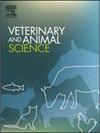Milk sustainability in specialized farms as affected by farm size and culling rates: A new perspective for allocation
IF 1.9
Q2 AGRICULTURE, DAIRY & ANIMAL SCIENCE
引用次数: 0
Abstract
Several studies investigated the sustainability of dairy cattle systems. Global warming potential (GWP) is a “touchstone impact category” of LCA, whereas fossil depletion (FD) remains a scarcely studied environmental indicator. This study aims to help fill the gap of knowledge on FD in dairy cattle systems. We compared two highly specialized dairy cattle farms equipped with precision technologies: a large (L) and a small (S) farm. The discriminants were the number of lactating cows and the agricultural area, with L having approximately twice the heads and three times the area of S.
In LCA we used the main product (FPCM, i.e., 1 kg of milk normalized for fat and protein), as the functional unit (FU). A second FU was used, i.e., hectare of occupied area. By changing the FU, the study showed different results, because S performed better when FPCM was used while L performed better when the agricultural area was used.
Allocation of culled cows affected the environmental impacts of both farms improving their sustainability. A high culling rate provides information on herd management, and it can result in lost income. We proposed the allocation as helpful to quantify the culled cows, a potentially undesirable product, showing a significant difference between farms, i.e., 30 and 38 % of culling rate in the L S, respectively. In S, this rate led to a higher income percentage provided by culled cows (6.3 vs. 4.2 % of L). Allocation decreased the equivalents of some LCA environmental indicators, showing an oversized replacement of cows.

受农场规模和淘汰率影响的专业农场的牛奶可持续性:分配的新视角。
几项研究调查了奶牛系统的可持续性。全球变暖潜势(GWP)是LCA的“试金石影响类别”,而化石消耗(FD)仍然是一个很少研究的环境指标。本研究旨在帮助填补奶牛系统中FD知识的空白。我们比较了两个配备了精密技术的高度专业化的奶牛养殖场:一个大(L)和一个小(S)农场。判别因素是泌乳奶牛的数量和农业面积,其中L的头数约为s的两倍,面积约为s的三倍。在LCA中,我们使用主要产品(FPCM,即1公斤脂肪和蛋白质标准化的牛奶)作为功能单位(FU)。使用了第二个单位,即被占领地区的公顷。通过改变FU,研究得到了不同的结果,因为使用FPCM时S表现较好,而使用农业区时L表现较好。被淘汰奶牛的分配影响了两个农场的环境影响,提高了其可持续性。高扑杀率提供了畜群管理方面的信息,但可能导致收入损失。我们提出的分配有助于量化被淘汰的奶牛,这是一种潜在的不受欢迎的产品,显示出农场之间的显著差异,即L S的淘汰率分别为30%和38%。在S,这一比率导致淘汰奶牛提供的收入百分比更高(6.3% vs. L的4.2%)。分配减少了一些LCA环境指标的当量,表明奶牛的替代量过大。
本文章由计算机程序翻译,如有差异,请以英文原文为准。
求助全文
约1分钟内获得全文
求助全文
来源期刊

Veterinary and Animal Science
Veterinary-Veterinary (all)
CiteScore
3.50
自引率
0.00%
发文量
43
审稿时长
47 days
 求助内容:
求助内容: 应助结果提醒方式:
应助结果提醒方式:


